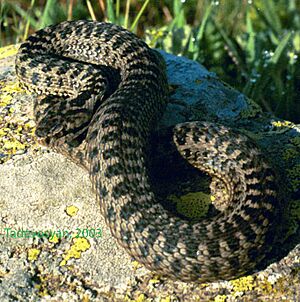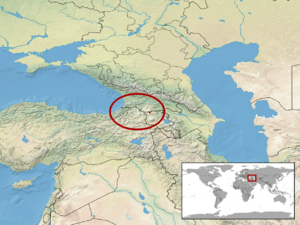Vipera darevskii facts for kids
Quick facts for kids Vipera darevskii |
|
|---|---|
 |
|
| Adult male Darevsky's viper from Armenia | |
| Conservation status | |
| Scientific classification | |
| Genus: |
Vipera
|
| Species: |
darevskii
|
 |
|
The Vipera darevskii, also called Darevsky's viper, is a small type of venomous snake. It belongs to the viper family, Viperidae. This snake lives in parts of northwestern Armenia, northeastern Turkey, and possibly southern Georgia. There are no different kinds or subspecies of this viper.
Contents
What's in a Name?
The name darevskii honors a Russian scientist. His name was Ilya Sergeyevich Darevsky. He studied reptiles and amphibians.
About its Venom
Darevsky's viper is a small snake. Its bite can be painful and cause swelling where it bites. However, it does not seem to be deadly for adult humans.
What it Looks Like
Male and female Darevsky's vipers look different. They vary in size, color, and patterns. Female vipers can grow up to 42.1 cm (16.6 in) long, including their tail. The largest male found was 25.8 cm (10.2 in) long.
The snake's back is light brown to gray. It has a dark brown or black zigzag pattern along its spine. There is also a row of small dark spots on each side of its body. Its belly has many gray or black dots. Females have a grayer belly. Males have an almost black belly with some white spots.
The scales on its chin and lips are white. There are a few dark, fang-shaped marks on its lip scales. This helps tell it apart from a similar snake, Vipera eriwanensis. That snake has a slightly pink color on its lip scales.
Adult males are usually brighter and have more color contrast than females. Females have a browner background color and a less clear pattern. Adult males have a lighter background color with a yellow tint. Their dark pattern is often black. The scales on its back are ridged. The top of its head has large scales.
Life Cycle
Not much is known about how Darevsky's viper grows. We also don't know how long they live.
What it Eats
Like all snakes, Darevsky's viper is a hunter. It eats lizards, small rodents, and orthopterans (like grasshoppers). Its strong venom helps it digest food very quickly. For example, it can digest small rats in just three days. Scientists think these snakes need to eat a lot.
Reproduction
Darevsky's viper gives birth to live young. This is called ovoviviparous. They mate in May, after shedding their skin for the first time in spring. Females eat a lot during the warm months. They give birth to 4 to 8 babies between September and early October. Newborn vipers are tiny, only 15–18 cm (5.9–7.1 in) long. They weigh about 0.5 g (0.018 oz).
Newborn Vipers
For their first two weeks, newborn Darevsky's vipers use food from their yolk sac. They grow without eating during this time. They get ready for their first skin shed, which happens in 10 to 14 days. We don't know if baby vipers eat before their first winter sleep. Generally, baby Darevsky's vipers eat newborn rock lizards and small orthopterans.
Where it Lives
Darevsky's viper is a mountain snake. It is found in the southwestern Dzavakhety Mountains in Shirak Marz of Armenia. It also lives on Madatapa, Javakheti Ridge, Erusheti Mountains, and Akhaltsihe Highland in Georgia. You can also find it in the east of the Artvin Province and Ardahan Province of Turkey.
The first place where this snake was found was "Mount Leghli" (Achkasar). This is in the Mokrye mountains, in the Gukasyanskii region of Armenia.
Its Home and Environment
The mountains where Darevsky's viper lives have special weather. They are the coldest and wettest part of the Armenian Highland. About 1,000 mm (39 in) of rain falls there each year. Even in the hottest months, July and August, hot days cause a lot of water to evaporate. This forms clouds. Almost every evening, these clouds bring rain, keeping the area moist.
At night, temperatures often drop to just 4-6 °C (39-43 °F). In the mornings, thick fog often covers the mountains. The sun has to break through it to warm the east-facing slopes. This warmth is important for the viper to be active. Some areas, especially on north-facing slopes near mountain tops, always have snow and ice. These spots are not good for snakes.
The best places for these snakes are rocky areas. These are mainly on steep, warm, south-facing and southeast-facing slopes. They are found in deep mountain valleys. The height is between 2300–3000 m (7,550-9,840 ft) above sea level.
High mountain rock piles and rocky outcrops surrounded by grassy areas are their main habitat. These rocky places give snakes deep dens for winter. They also provide daily shelters. These shelters protect them from getting too hot or too cold. They also hide them from predators. The rocky areas also have important food sources. These include rock lizards and small rodents.
Darevsky's vipers are active during the day. They often move inside the rocky areas to keep their body temperature just right. Their ideal body temperature is about 26–28 °C (79-82 °F). We know very little about what animals hunt this viper. Remains of this snake were found in the droppings of a beech marten.
Land Use and Protection
Local people use the mountain slopes where Darevsky's viper lives. They use them for grazing their cattle and for cutting grass. A large part of this snake's home in Armenia is now part of the Lake Arpi National Park. This helps protect them.
Conservation Status
Darevsky's viper is in serious trouble. It is listed as critically endangered (CR) by the IUCN Red List of Threatened Species. This means its habitat area is very small, less than 100 km2. The actual area it lives in is even smaller, less than 10 km2. Its population is broken into small, separate groups. Also, its habitat is shrinking. This information was last checked in 2009.


